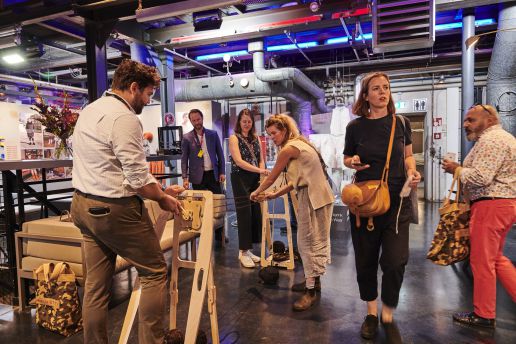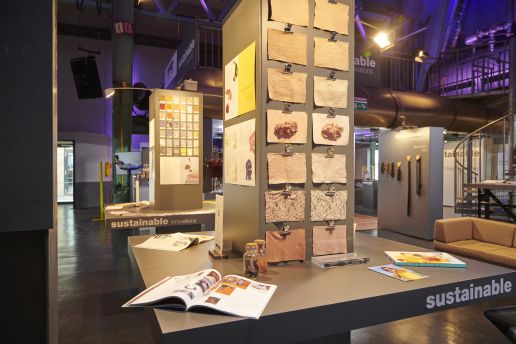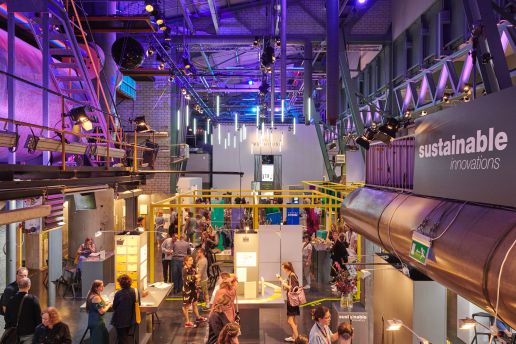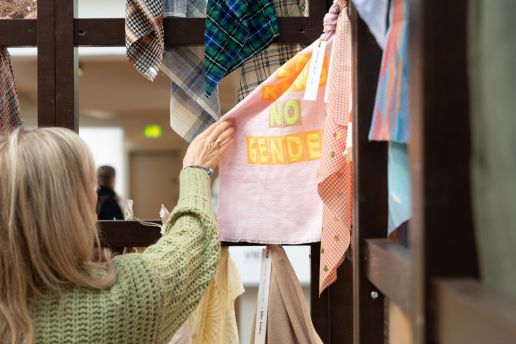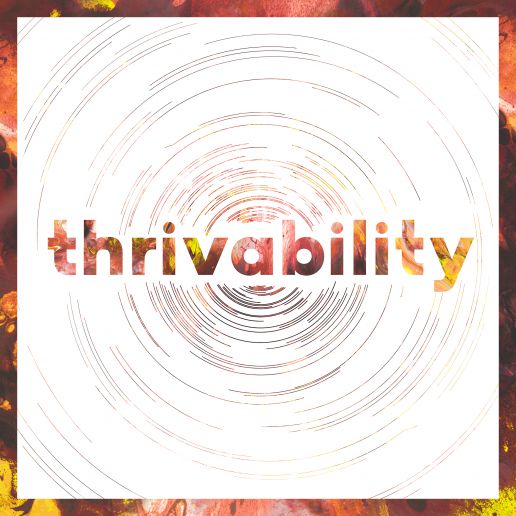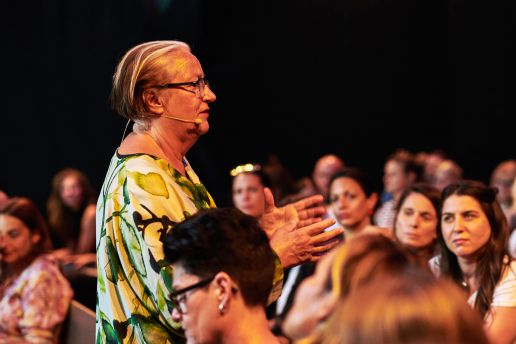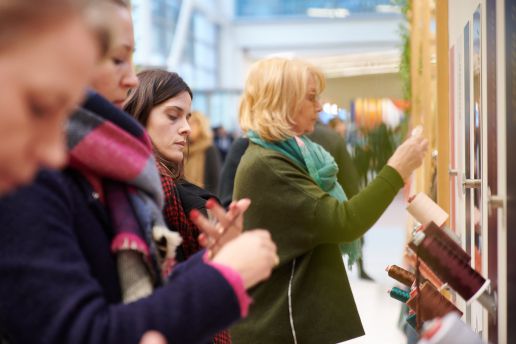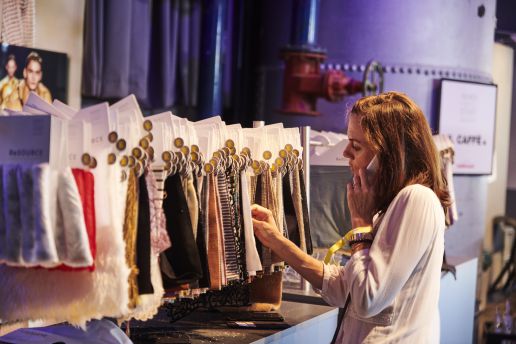Munich Fabric Start
New Icon Guidance System to increase Transparency
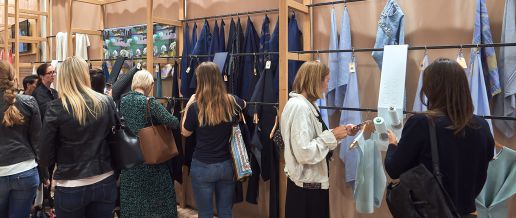
Answering to the theme of innovation driven by THRIVABILITY, MUNICH FABRIC START has developed a new icon guidance system with which all material highlights presented in the trend forums are marked according to their sustainable as well as technical functions. In this way, trade fair visitors can quickly and clearly see what additional product features and functions the shown fabrics and ingredients have.
Each of the 44 icons indicates a specific characteristic related to the sustainability or performance of the respective product. With the help of these icons, manufacturers can highlight the added value of their products and at the same time make it easier for interested buyers to navigate through the increasingly vast range of products on offer.
“With our new icon guidance system, we are highlighting the interface between contemporary aesthetics and invisible but important advanced product features. In doing so, we see MUNICH FABRIC START neither as a certification body nor an audit agency – for the given classification, we rely on the information and honesty of the respective supplier of the corresponding samples. We are thus taking an important step towards information, transparency and responsible action in the interest of the industry.
Jo Baumgartner, Fabrics & Trends MUNICH FABRIC START
In this sense, all specific properties such as eco-labels, social standards, performance indicators, limit values, chemical ingredients, etc. must be verified again with the respective provider. In the trend forums at MUNICH FABRIC START, you will find the icon legend with the corresponding explanations and meanings behind all of the icons.
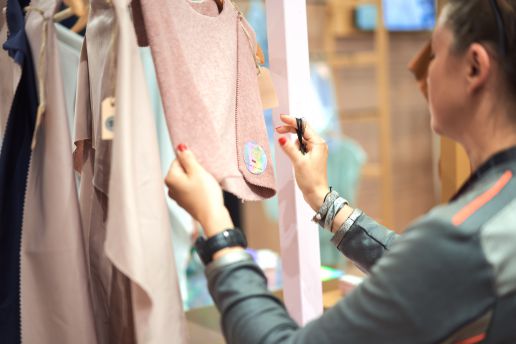


Looking Back: 2019 Hightex Award Winners
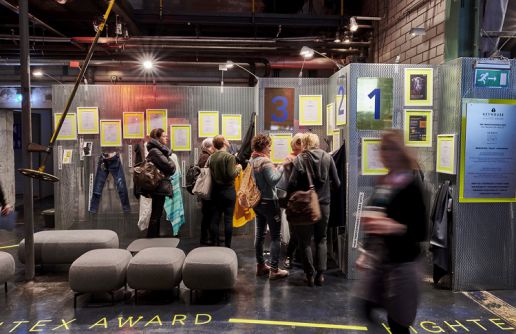
The Hightex Award is an opportunity to recognise the most significant, innovative and resourceful developments selected among Munich Fabric Start and Bluezone exhibitors. As we prepare to showcase the novelties of 2020, let’s take a look through the 2019 winners of the 6th & 7th editions of Hightex Award.
January 29th – 31st 2019 Edition of Munich Fabric Start
1st Place
Becker Tuche from Aachen has been awarded for a new, super lightweight and highly functional product development consisting of a combination of wool and Cordura with spandex. Despite the low weight, the new fabric has a high abrasion resistance and a very high water vapour permeability. The new product is ideal for outdoor styles, streetwear and corporate fashion.
“I am very pleased with this Award. For more than a year now we at Becker Tuche have looked into mixing various clothing segments from fashion, sportswear/outdoor, Corporate Fashion and workwear. Against this background the Wool Performance series combines classic wovens in wool and wool blends with such functions as wind breaking and waterproofing well-known from sportswear. The result is an individually coordinated quality portfolio fit for many applications. In response to the strong interest we are currently developing other fabrics made of wool/Cordura with technical functions.”
Peter Recker, CEO Becker Tuche, Aachen
2nd Place
The second place was received by Soorty Enterprises for “Rain Shield”, an extremely light, recycled and water-repellent denim in Tencel/Nylon blend that impressed not only numerous features but also with its elegant look. The fast-drying, water-repellent, heat-insulating and form-resistant product also scored with a soft grip and subtle gloss finishing.
3rd Place
Mectex by Manifatture Italiane Scudieri came in third place with two Hyperlight 3Layer fabrics and the associated continuous development of innovations and functional materials. The Italian company always finds new ways and solutions to combine comfort and function perfectly and is known for its high-tech developments in the sportswear and outerwear segment. For example, heat-insulating, reflective and ultra-light qualities with water-repellent, bacteria-resistant and breathable graphene membrane that glow in darkness.
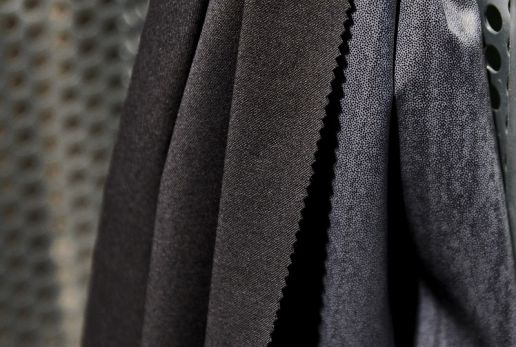
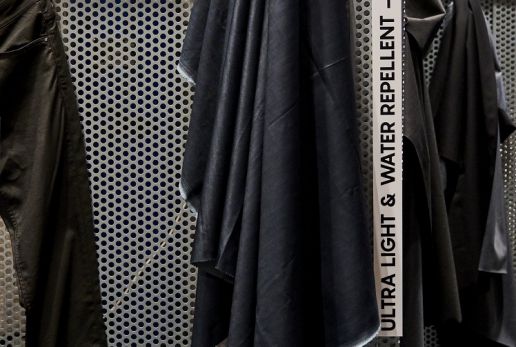
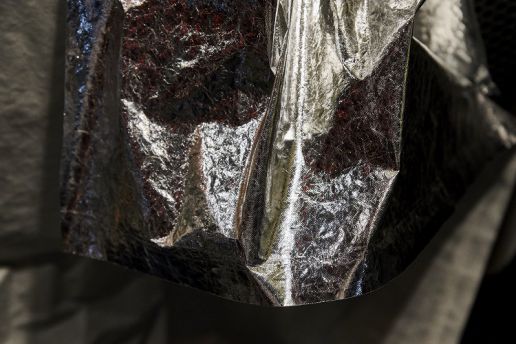
September 3rd – 5th 2019 Edition of Munich Fabric Start
1st Place
RDD TEXTILES from Portugal wins first place with a bonded double-sided jersey quality. Outstanding was the jury’s assessment of the development of this new bonding technique through an environmentally conscious mechanical process and newly developed without any additional adhesive. For the filling, 100% Tencel TM which uses an environmentally friendly fiber. According to RDD Textiles this excellent jersey quality, first introduced at MUNICH FABRIC START, is breathable, warming, comfortable, extremely lightweight and absolutely fashionable.
„We are very happy about this award, which we have now received for the second time. The award especially means a lot to us because this now award winning article is a real novelty. For the launch of this outstanding jersey quality, the HighTex Award is a welcomed marketing tool to publicize this novelty in the marketplace.“
Elsa Parente, RDD TEXTILES
2nd Place
Second place goes to M.T.T. SPA MANIFATTURA TESSILE TOSCANA from Italy for a wool quality with 14 percent polyamide content currently offered at a high fashion level. This is ensured by a graphic PU print in a technically aesthetic vinyl look. Abrasion and pilling are drastically minimized by this fashionable way of coating. Ideal for trend-setting womenswear with classic wool properties.
3rd Place
Third place goes to fabric specialist BRUGNOLI, also based in Italy, with a highly functional 3-layer technology. New is the use of bio-based polyamide. The elastic protective membrane is waterproof, windproof and breathable and therefore predestined for outdoor fashion. The first layer is made of extra fine merino wool and bio-based polyamides. The second layer offers a high degree of comfort and functional protection as an extra thin elastic membrane. With the third layer featuring extremely thin polyamides plus elastane. The result is a soft shell quality for jackets and pants that is already used by well-known Italian fashion and function brands.
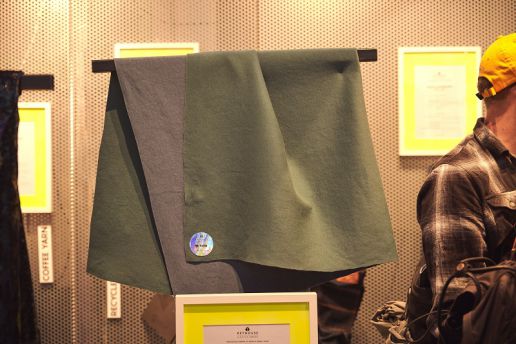
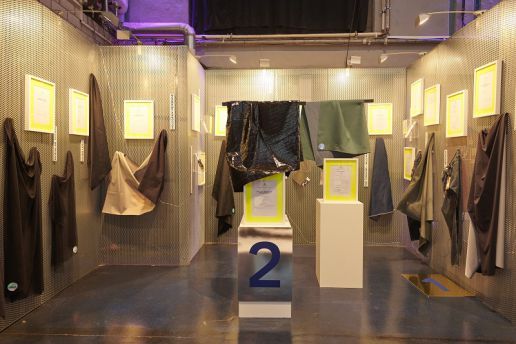
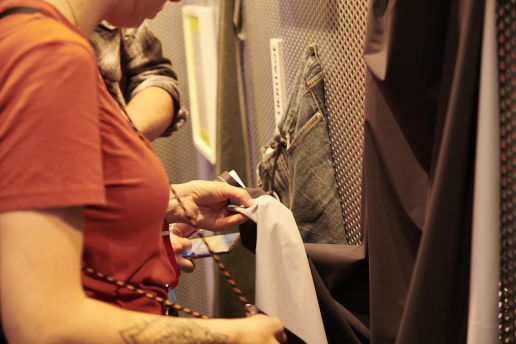
Amidst the current restructuring of our industry and in order to meet innovation cycles and grant enough time for new developments, the organisers of MUNICH FABRIC START have decided to relaunch the Hightex Award as an annual award beginning September 2020 with a newly designed format.
The HighTex Award is part of an overall conceptual approach by MUNICH FABRIC START as one of the world’s largest textile fabric fairs for intelligent process solutions, innovative highlights, biotech, digitization and sustainable innovation.
„We see the HighTex Award as recognition for outstanding achievements and at the same time as motivation which encourages unique innovation projects. It promotes sustainable contributions towards a clean future and more conscious use of resources thanks to the innovative use of materials. Our congratulations to the top three companies and our respect to the performance and commitment of all of the participants and their innovative product developments.”
Frank Junker, Creative Director MUNICH FABRIC START

Monsieur-T’s Denim Duo in Conversation
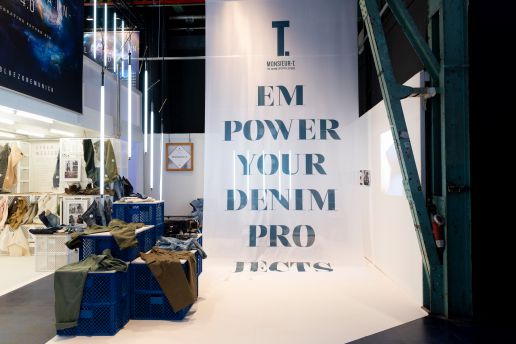
Close colleagues and friends of the BLUEZONE and MUNICH FABRIC START team, Lucie Germser and Tilmann Wröbel are the dynamic denim duo at Monsieur-T Denim and Bottom’s Studio. In an interview with Carved in Blue, our favourite denim heads talk about the inspirations and unique circumstances which led them together to hold such a significant and authoritative role in the denim world.
Germser, Head of Communication & Design at the international design studio, and Wröbel, Creative Director, work together with our team of trend experts to define and curate the denim trends and information showcased at MUNICH FABRIC START’s denim dedicated trade fair BLUEZONE. Above offering their bespoke consultation services to our exhibitors and visitors, over the course of the two trade fair days at BLUEZONE, the pair regularly host relevant round tables as well as present the latest denim trend and information to our diverse audience.
Read more at Carved in Blue.
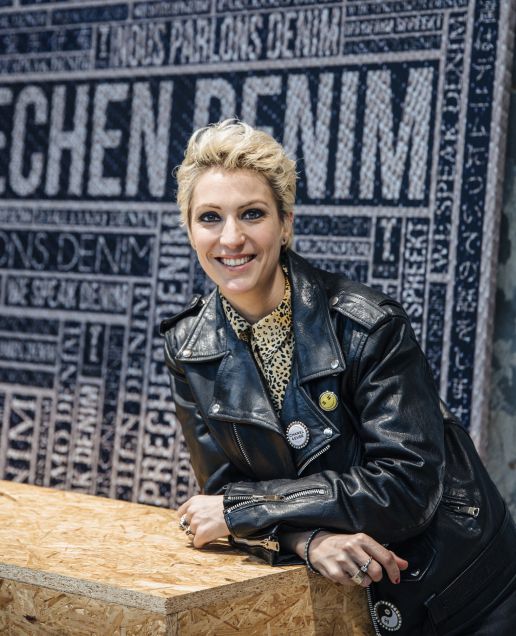
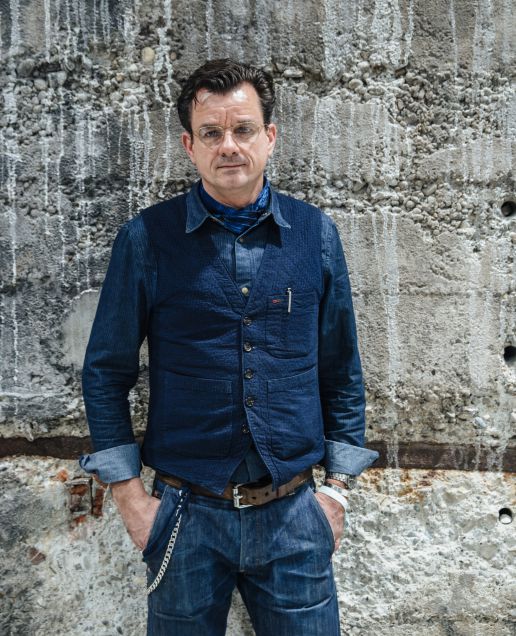
Spring.Summer 21 Fabric News at VIEW
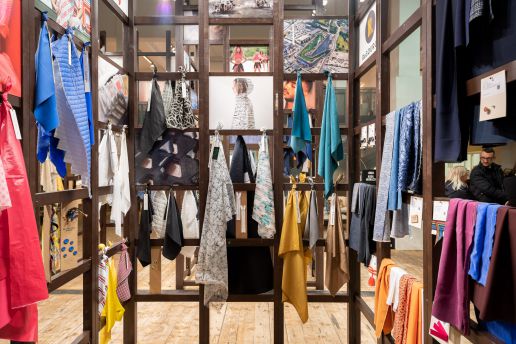
As in the recent past, the range of collections offered by printers, knitters, weavers and denim specialists is already clearly defined in many areas. In exchange with designers and product managers and taking into account current trends, the range will be extended and adapted accordingly until MUNICH FABRIC START, 4th – 6th February 2020.
It is already apparent that the range of colours is moving in the direction of brown, cognac and terracotta; that black and white combinations are becoming important; that red with a slight orange hue is gaining significance and blue in various shades is increasingly in demand.
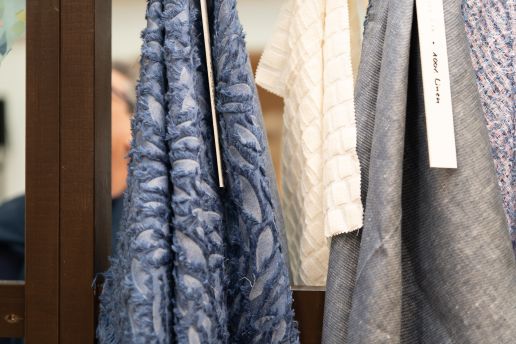
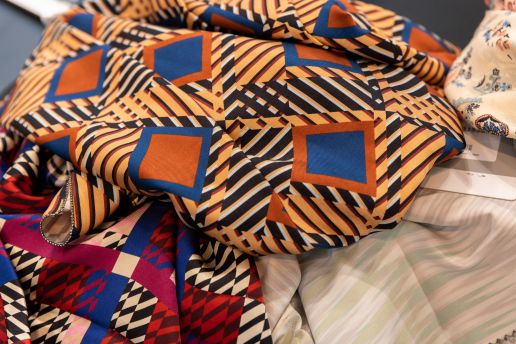
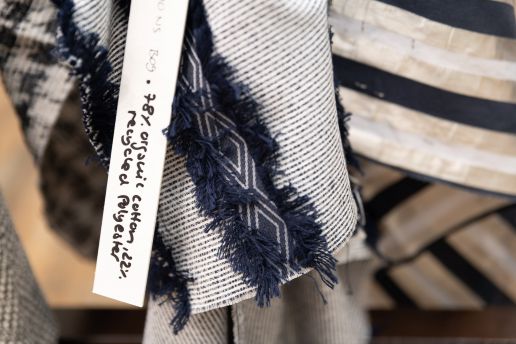
‘Right at the beginning of the first day, we served numerous visitors from Germany and Austria. At the moment, we are already presenting up to 80 percent of the new collection. In the weeks after Christmas we will add an additional Capsule collection. There is great interest in sustainable articles. We will be developing further qualities for this in time for the main trade fair.‘
Ted Styliandis of Liberty London.
Florals and newly interpreted batiks continue to dominate the prints as striking all-overs. Digitally applied kaleidoscopic interpretations are just as convincing as large format graphics and panneaux prints. Structured effects and crepe yarns are important, even in plain colours. Linen is widely accepted in various interpretations. From irregular plain colours to woven stripes, checks and jacquards. The trend towards cotton and cotton blends in combination with Tencel is strong once again. In contrast to this are articles with a technical finish – now even extending into the classically oriented women’s and menswear.
The demand for comfortable textiles with some part stretch is also increasing among high-fashion producers or even couture suppliers.
‘This edition of VIEW was a very successful premiere for us. We will be back again in summer for the next VIEW event. The response to our wide range of print collections was pleasingly positive. In discussions with numerous customers, we received a lot of input about the future development of our collection in time for MUNICH FABRIC START.‘
Yesim Sezer, Ipeker
Many of the collections presented at VIEW will now be further revised in the coming weeks and presented at the MUNICH FABRIC START February 4th-6th 2020, at which a total of around 1,000 suppliers will present their Spring.Summer collections.
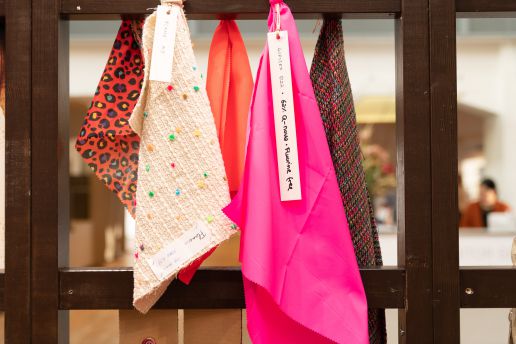
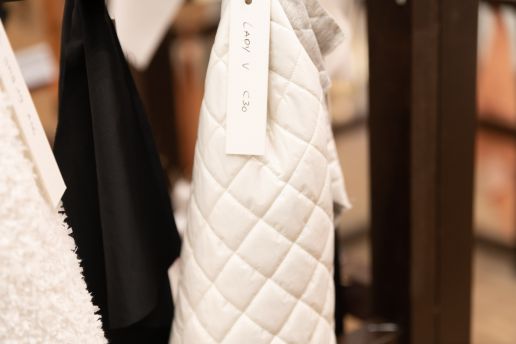
A Discussion About SusTECHability
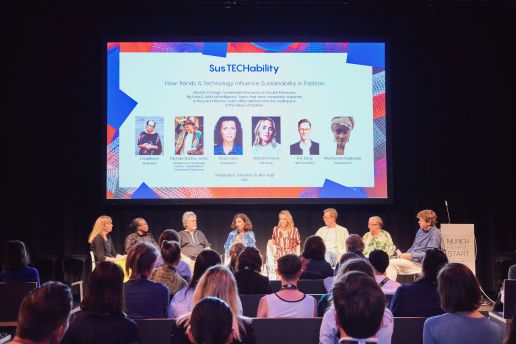
More than ever, the future of the textile and fashion industry is determined by new and highly complex topics. Sustainability has become the main driver in the fashion industry revolution, combining the awareness of greater consciousness with an increasing and urgent responsibility of all involved.
“Sustainability isn’t a trend; it’s a fact. As tradeshow organizers, we feel obliged to provide an internationally established platform for targeted solutions, sustainable innovations and discussions surrounding these issues. We see ourselves as a platform and a voice of the industry. And in this role, we offer a significant advantage in terms of awareness and reach.”
Sebastian Klinder, Managing Director, MUNICH FABRIC START
Alongside sustainability, digitization and technology are the complementary catalysts that increasingly redefine product and process solutions and, in doing so, provide significant momentum for the progression of one of the world’s largest industrial sectors.
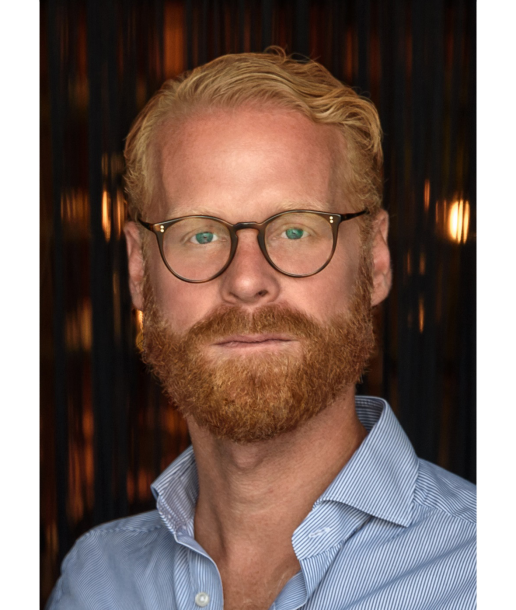
Digitization, such as what’s found through blockchain technology, makes it possible to guarantee the level of transparency demanded by the consumer. In addition, there is the prospect of a new visual aesthetic—and thus optic innovations—that can only be created through the use of digital technologies.
“Fashion has to pursue a hybrid approach overall so that the apparel industry can really opt for sustainable innovation, allowing it to implement sustainability initiatives with a high degree of design, disruption and integration of new technologies,” Muchaneta Kapfunde, founding editor-in-chief of FashNerd.com, said.
Such practices can already be found today. Rosanne van der Meer, founder of The Girl and the Machine, which designs and produces personalized knitwear based on 3-D knitting techniques, demonstrates this with the NIO New Industrial Order personalized fashion laboratory. “At first, I thought it was a problem that sweaters developed with 3D technology looked different than conventional, traditional knitted styles,” she explained. Only in the course of the process did she realize that this could be a real and unique selling proposition, and that perhaps 3D knitting would establish its own recognizable look that could stand out from conventional styles.


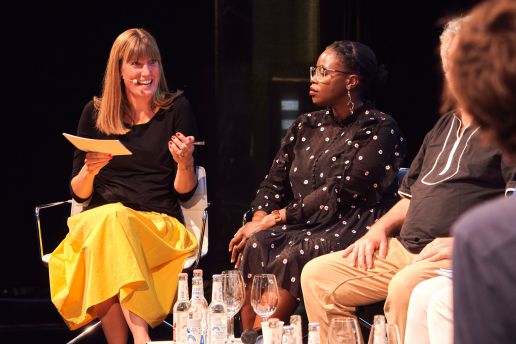
The textile and fashion industry is facing a fundamental upheaval. In order for the garment industry to rely on sustainable innovation, it is necessary to adopt a hybrid approach that enables sustainability initiatives to be implemented with a high degree of design and integration of new technologies. The demand for sustainable products and correspondingly transparent, resource-efficient production is one of the most urgent challenges faced by all suppliers and producers of relevant fabrics and accessories.
This assessment is mirrored by Alex Vogt of Kern Consulting, an analyst for innovation and corporate responsibility. Vogt views technological developments as the key to dissolving the current contradiction between a growing textile industry and the need to conserve resources. “Ranging from transparency, recyclability to surplus production, the potential applications for big data, artificial and amplified intelligence are wide and varied,” he said.
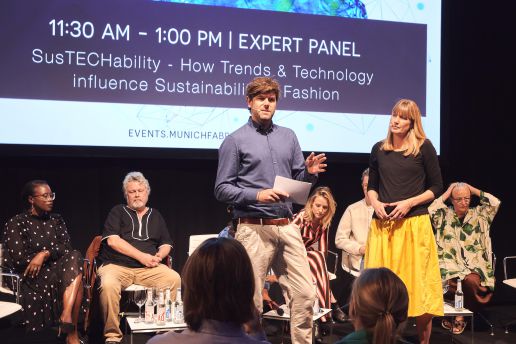
“Certainly this panel was significant in its disciplinary range and approach. Thus, a discourse emerged between the public-sociological perspective, with Li Edelkoort, the UN and the media on the one hand, and the H&M Foundation, Lenzing and EON on the other as those who are bringing real innovation to the industry.”
Alex Vogt, KERN Consulting
Munich Fabric Start currently presents these fields through concrete showcases, substantiated information and numerous new products for a broad market, thus promoting this necessary dialogue. As one of the most important international fabric trade fairs, with more than 1,000 suppliers of fabrics and additional items—showcasing well over 2,000 collections per season—Munich Fabric Start has been engaged with issues surrounding innovation from a very early stage.
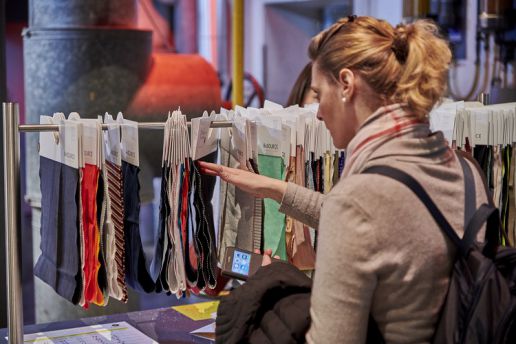
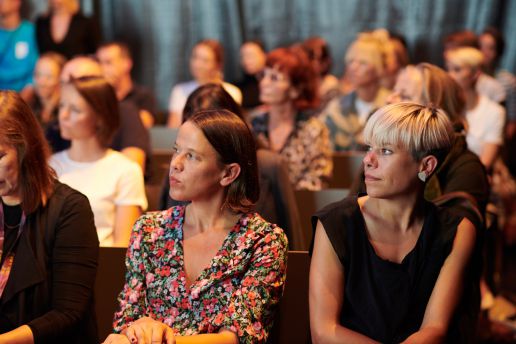
Through a series of dedicated areas for each segment, supported by proven experts and associations, the trade fair offers a comprehensive range of beautiful, certified fabrics and accessories. As a think tank for new technologies, sustainable innovations and smart textiles, the Keyhouse area of the show bundles new approaches in these areas through interactive presentations. Acting as a communication forum for dialogues, interviews, statements, seminars, panels and round tables, it serves as the ideal platform for synergies and cooperation.
“At Munich Fabric Start, particularly in the Keyhouse, there is a very special atmosphere. Here the most varied forms of creativity collide. Moreover, we use this opportunity to explain our products, strategies and co-operations in seminars and to launch projects,”
Tricia Carey, Director Global Business Development, LENZING FIBERS

As the representative of a strong community, now more than ever viewed as responsible for initiating processes, it makes expertise accessible, ultimately providing the tools and solutions for these future-oriented processes.
Content, communication and connection are the elementary parameters of a textile and fashion industry that is currently reorganizing itself. A change of thinking is occurring, and Frank Junker, creative director Munich Fabric Start, pointed out the great commitment held by the fair to make a significant contribution to the redefining the future of textiles.
“With the help and support of experts, renowned enterprises and ambitious startups—combined with courageous creative minds and committed young designers who are shaping their own future in new ways—we are setting new standards in a very focused and solutions-oriented way.”
Frank Junker, Creative Director, MUNICH FABRIC START
As future vertical brand co-operations become increasingly important, the goal must be to integrate performance characteristics and sustainable solutions within clothing in such a way that it becomes a real selling and buying argument that resonates with respective fashion brands. Against the backdrop of a multifaceted and hugely diversified industry, Munich Fabric Start is positioned as a platform for intensive business and successful networking.



The next Munich Fabric Start will take place Feb. 4-6, 2020, and will showcase the main topic THRIVABILITY.
Discover the list of exhibitors here.
New Season Ushers in New Theme, Topics and Trends
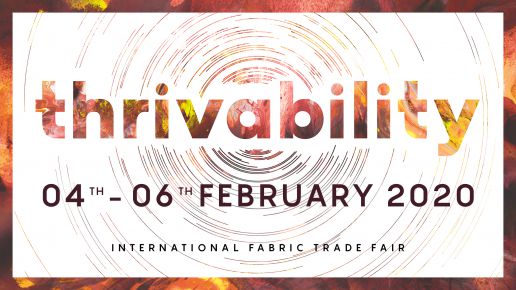
It is time once more to reveal the new key visual which marks the start of a new season here at Munich Fabric Start. Over the last couple of months our team has uniquely interpreted and defined the trends and theme of our next show taking place February 4-6 2020. Read more about how trends are made at Munich Fabric Start
Here we offer the first interpretations of the upcoming Spring.Summer 2021 season titled, THRIVABILITY which presents a season of flourishing respect for fashion, nature and people. Thrivability invites us both together and as individuals to focus on a higher level of quality and to shape our global and individual future with enthusiasm and confidence. The season Spring.Summer 21 surrounds itself by an aura of dynamic waves, radiates with evolutionary, energetic sustainability and shimmers in social, biological diversity.
The rapidly growing trend towards ecology allows a new entrepreneurial spirit of holistic awareness to flourish. It serves the customer’s longing for knowledge, creates transparency and stimulates textile education towards all directions. Continuous innovations and classic fashion trends are deep-rooted in an altruistic, inspiring way of thinking, they cultivate a progressive reorientation in the fields of materials, fashion and design.
Monsieur-T denim and graphic designer, Lucie Germser has over 20 years of experience in our industry and has beautifully represented the theme of the new season.
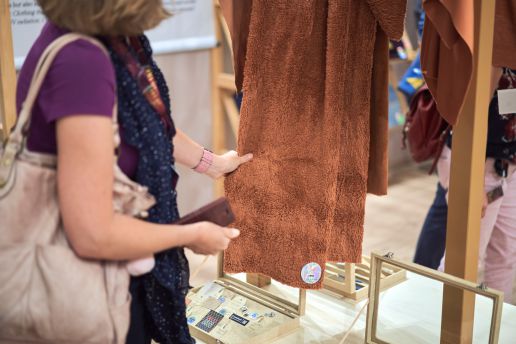
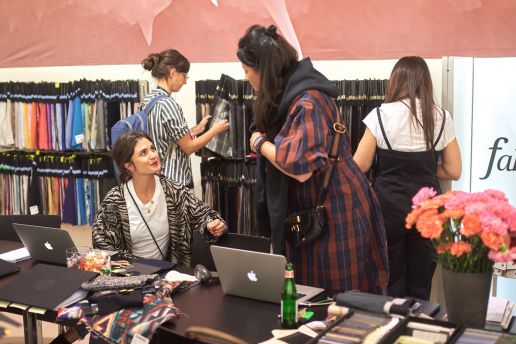

You’re invited to attend MUNICH FABRIC START, where more than 1000 suppliers will present more than 1800 collections for Fabrics and Additionals for Spring.Summer 2021.
MUNICH FABRIC START: 4-6 February 2020
BLUEZONE: 4-5 February 2020
Exclusive Trend Seminar by Li Edelkoort
Li Edelkoort, icon of trend research, will hold one of her exclusive trend seminars at Munich Fabric Start. She will present GREEN WAVE, the fashion trends for Spring/Summer 2021, STILLNESS, the full Colour Forecast for Autumn/Winter 21/22 as well as GREEN BOOK, the full forecast for Recreationwear Trends. This exclusive and unique event is the perfect inspirational source and working tool for all those who live design.
TREND SEMINAR PROGRAM
3.30pm – 4.00pm : Registration & Welcome
4.00pm – 5.00pm : GREEN WAVE – Fashion, Shapes & Textiles and Colours for SPRING/SUMMER 2021 – Full Trend Presentation
5.00pm – 5.30pm : STILLNESS – New Colours for AUTUMN/WINTER 21/22 – Full Colour Forecast
5.30pm – 6.00pm : GREEN BOOK – Recreationwear Trends & Colours SPRING/SUMMER 21 – Full Trend Forecast
6.00pm – 6.30pm : Meet & Greet Drinks with Li Edelkoort
Find more information and the first insights of the trend program here.
ORDER YOUR PERSONAL TICKET NOW FOR 220,00 EUR
Please register in advance as seating is limited.
Access can only be granted with a valid ticket.
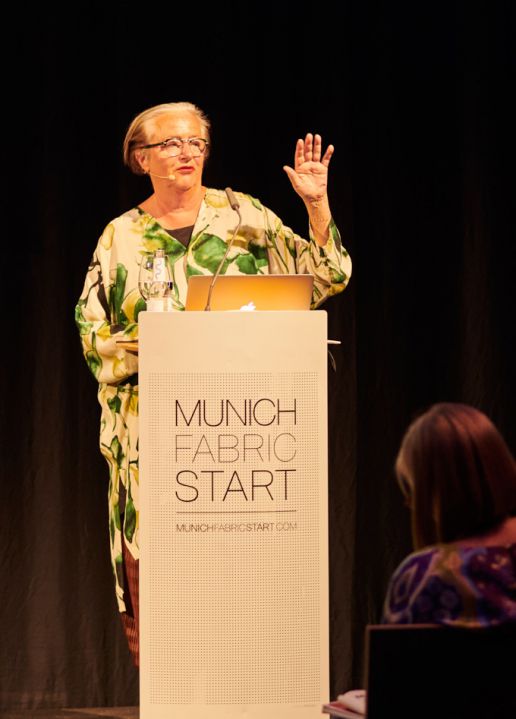
MUNICH FABRIC START Autumn.Winter 20/21 Highlights
The recent MUNICH FABRIC START from 03 - 05 September 2019, launched the new Hall 8 and an extended exhibitor portfolio to once again convince the sector of the innovation and information platform. Featuring highly concentrated themes, new exhibition formats and numerous expert-led panel discussions, keynotes and lectures. Now spread over eight halls, for the very first time over 1,000 international suppliers showcased more than 2,000 collections in the Fabrics, Additionals, Denim and Sourcing segments for Autumn.Winter 20/21.
https://www.youtube.com/watch?v=CzjDymECCMs&feature=emb_title
A Conversation On Sustainability, Transparency & Mainstream
From slow fashion to mainstream business, materials to education, fashion and sustainability raise so many questions. A vast and complex issue, Muchaenta Kapfunde of FashNerd turned to 3 women making a difference in the sustainable fashion space.
Charney Magri a fashion photographer turned documentary maker. The co-founder of Fashion 4 Change has worked for the likes of British Vogue and Ralph Lauren, and now she is a partner for do epic sh*t. Olivia Pinnock is a London-based fashion journalist, lecturer and founder of The Fashion Debates. She is dedicated to uncovering insightful stories in a fascinating industry and promoting positive change for a more sustainable future for it. Abigail Morris is the Founder and CEO of Compare Ethics. It is a start-up that connects you to ethical brands through the latest online and offline experiences. Since launching in 2018, Compare Ethics is regularly featured in top social feeds and connects thousands of ethical shoppers with brands each week.
On the topic of sustainable fashion, I asked Charney, Olivia and Abigail to share their perspective on the most commonly asked questions.
CHARNEY MAGRI
Do you think that eco-fashion is still a niche market? If so, why?
The day that ‘Eco Fashion’ is just called ‘Fashion’ and is accepted as the norm, will be the day that I believe ‘Eco Fashion’ is no longer niche but rather just common sense.
In your opinion, what are the top 3 things that brands should focus on with regards to promoting their sustainable practice?
I don’t believe there are three focuses on promoting a sustainable brand. However, there are two main verticals in sustainable fashion: environmental and human rights. Both need to be addressed and both need to be made transparent for the success of any [sustainable] brand. As a visual communicator, I want to see all brands talking about this to their consumers as well as the right certifications in place to verify their practices.
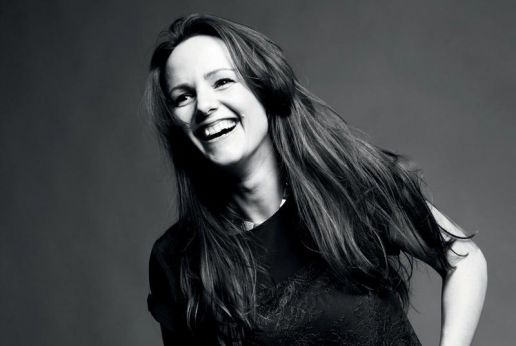
What advice would you give an individual looking to start-up a sustainable fashion retailer, particularly with the threat of a current ‘retail recession’?
Research is the first most crucial piece of advice. But the biggest obstacle you will come across is finances. Sourcing sustainable fibres and fabrics are more expensive than unsustainable options and mills will not accept small runs. You must build relationships with suppliers to be able to get the smaller quantities needed, and this takes time. I really believe there is a future in collaborating with like-minded designers to approach companies together so you can fulfil your orders when starting out.
ABIGAIL MORRIS
In your opinion, what are the top 3 things that brands should focus on with regards to promoting their sustainable practice.
1) Create a strong storytelling environment. Whether via online or offline experiences, sustainability is best shared as a story that people can easily back and tell their friends.
2) Be authentic. Nobody is perfect when it comes to sustainability. Bring people on your journey and celebrate your achievements with your community in real time.
3) Strive for increased transparency. Open up your supply chain and show people you are working to the highest ethical standards. Whether you are showing who made your clothes or using blockchain to track your supply chain, people increasingly want to know the provenance of your products.

Do you think ethical clothing will ever out-compete the mainstream less ethical products and dominate the fashion industry in the future? Why?
I don’t think new ethical clothing alone will out-compete the mainstream. However, what is more, interesting is how new business models will disrupt the fast fashion industry. ThredUp found that the second-hand market is growing 21 times faster than retail apparel over the last three years and is on track to be larger than fast fashion by 2028. At the same time, fashion rentals and sustainable fashion are moving into the mainstream. Given that fast fashion relies on volume, it will be interesting to see how and when mainstream brands will pivot towards a conscious fashion future.
Why do you think people are still buying from mainstream shops that sell unethical clothing?
People still buy unethical clothing because there is a variety with a strong product-market fit, and it is super easy to find. Sustainable fashion is making amazing strides on these areas. We increasingly see brands get product quality, price point and aesthetics right, but we need more choice and scale to compete. This has to be coupled with an easy way to find sustainable products. This is why we set up Compare Ethics – we know there are amazing sustainable products out there, it just has to be easy to find them.
OLIVIA PINNOCK
What do you see as the biggest challenge in getting customers to seek out more ethical and sustainable alternatives to high street fashion?
The biggest challenge is the convenience of mainstream fashion. It is far easier to seek out familiar brands that the consumers’ trusts, are fresh in their minds because of advertising and offers affordable fashion with next day delivery than it is to look for alternatives. Greenwashing is another issue that does damage to the whole sustainable fashion community as shoppers are not sure who they can trust.
What steps can we take to increase transparency and accountability for high street retailers?
I think governments have a tremendous amount of power in making the fashion brands that operate in their countries more transparent. We have seen it here in the UK with the Modern Slavery Act and the Environmental Audit Committee’s investigation into a fast fashion which bought CEOs from some of the biggest UK retailers into parliament to testify on what they’re doing about the issue. Companies are not going to give over information about their practices and their suppliers willingly for fear of giving valuable information to their competitors, but governments have the power to say that protecting garment workers and the environment is far more critical than that.
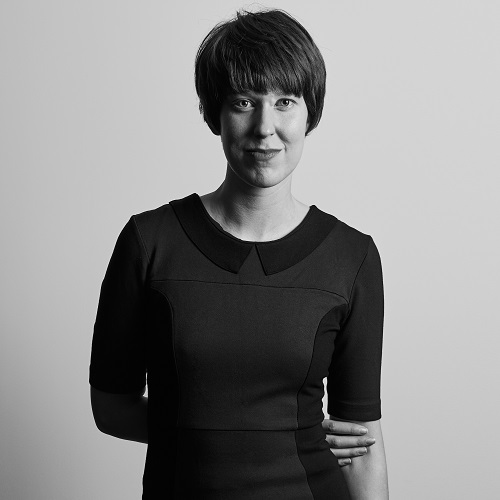
What advice would you have for people that want to be more conscious of their fashion choices?
Start with the wardrobe that you have. Consumers can make the most significant difference by changing how much they buy and how they manage their clothes at the end of their life. There are things you can do to support more ethical brands and put pressure on big brands, but where you can make an immediate, tangible impact is in your own home. Take steps to reduce how much clothing you’re buying, if it’s possible, and when you’re done with a piece of clothing, ask yourself whether it can be repaired or upcycled instead. If you still want to throw it away, can you give it to a friend to extend its life? It’s much better to give it to someone you know will wear it than take it to a charity shop where you don’t know where it will end up, especially if they can’t sell it if it’s not worth hanging on to someone, research how you can responsibly dispose of textiles in your local area through recycling schemes.
SUSTAINABLE INNOVATIONS: Interview with Simon Angel
You’re curating the Sustainable Innovations forum at Munich Fabric Start for the fourth time. Where are you looking for these new ideas and concepts?
I follow the heartbeat of current and future matters and perspectives. I am inspired by people and products which question the quality and essence of life. This leads me to the roots of the design processes, to the inner core of the industry, research institutes and universities. Textile innovations can be found in all different kinds of areas from fashion to health care, automotive as well as many other sectors. The art of thinking outside and inside the box at the same time plays a central role to find new innovations.

What do the showcased projects have in common?
There are two aspects which unite the Sustainable Innovations: poetry and purpose – and we most definitely need both! We need people who respond with poetry to inspire and open up new ideas and we need the hardcore problem solvers. With this edition we show several projects that provide concrete examples of what the successful interplay between poetry and problem solving can look like. Be it in 3D printing solutions or in human capital or in terms of circular solutions. Sustainable Innovations showcases great examples of what re-thinking and re-acting can lead to.
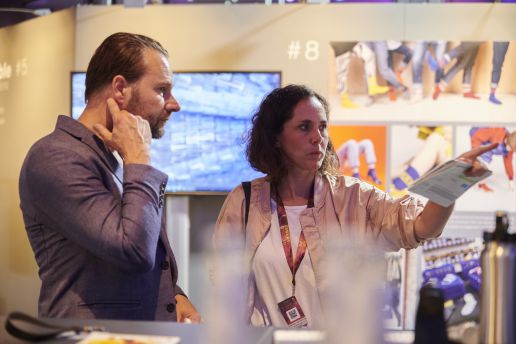
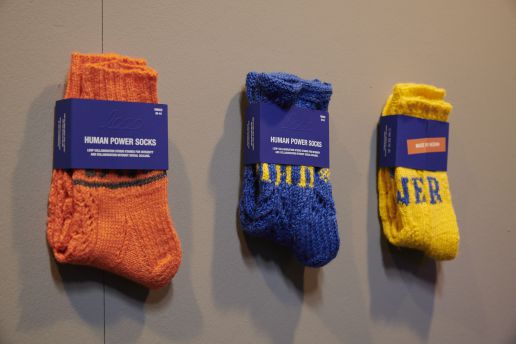
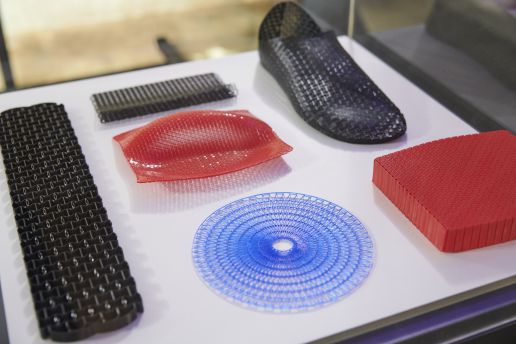
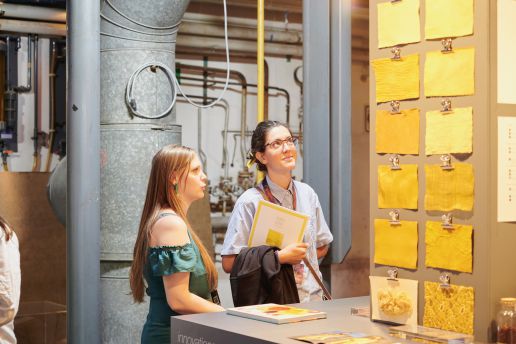
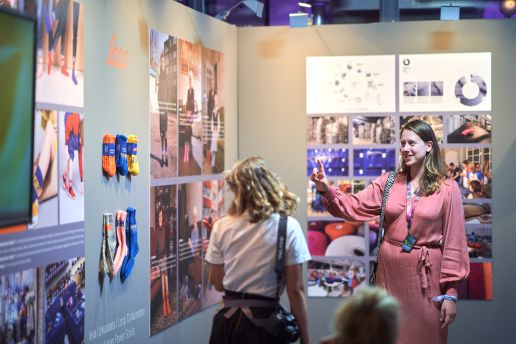
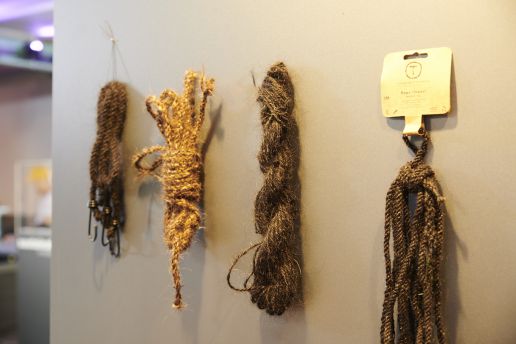
With regards to the exhibits, do you see any major trends?
I see the need for and can almost hear a desperate cry for contact. People want to develop a deeper relationship with each other but also with products and materials. The overload of information and the limitless possibilities to connect brings us to the essence of connection: purpose. The designers question their activities, relationships, products, services and business models in order to establish connections that make sense. Connections which will enable and explore new ideas, materials and directions. The power to create a new kind of connection is the next innovation: meaningful people, purposeful like poetry.

What can the industry learn from Sustainable Innovations?
Perhaps it’s not so much about learning something, but more about opening up and establishing a dialogue. The designer has their own view of the market as well as human needs and the industry has its own view and perspectives as well – but these two perspectives are not always sufficiently aligned. Therefore collaborations are key: BEyondAWARE!
